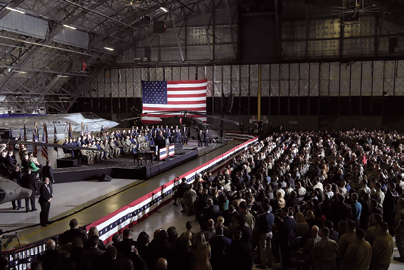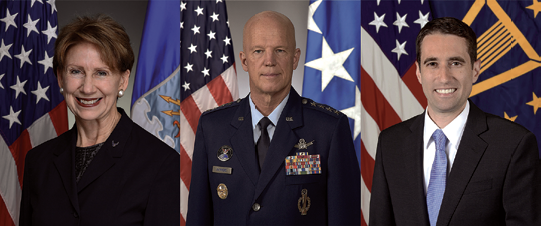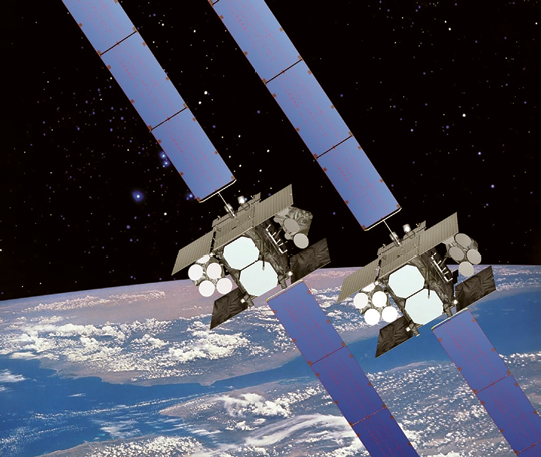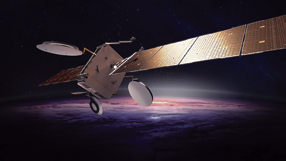
U.S. Space Force established
The President of the United States has signed the 2020 National Defense Authorization Act and, with that signing, directed the establishment of the U.S. Space Force as the sixth branch of the U.S. armed forces.

Secretary of Defense
Mark T. Esper
“We are at the dawn of a new era for our Nation’s Armed Forces. The establishment of the U.S. Space Force is an historic event and a strategic imperative for our Nation. Space has become so important to our way of life, our economy, and our national security that we must be prepared as a Nation to protect it from hostile actions,” said Secretary of Defense, Mark T. Esper.
He continued, “Our Military Services have created the world’s best space capabilities. Now is the time for the U.S. Space Force to lead our Nation in preparing for emerging threats in an evolving space environment. This new service will help ensure we are postured to deter aggression, defend our national interests and outpace potential adversaries.”
The U.S. military and the commercial sector rely heavily on space-enabled capabilities, and the Defense Department must protect those assets and maintain U.S. superiority in the space domain, the Deputy Assistant Secretary of Defense for Space Policy, Stephen L. Kitay said during an AFCEA luncheon last year.
He explained that the Department of Defense (DoD) is no longer viewing space as a support function, but as a warfighting domain -— a domain of potential crisis and conflict. The Space Force unifies space-related activities within DoD.
Kitay added that the nation needs to maintain space superiority and protect freedom of operations in that domain. ‘’Future operations will likely start or extend into space and we have to be ready for that eventuality.’’

Chairman of the Joint
Chiefs of Staff,
General Mark A. Milley
“Space is critical to our nation’s economic interests, national security, and way of life,” said Chairman of the Joint Chiefs of Staff, General Mark A. Milley. “In military operations, space is not just a place from which we support combat operations in other domains, but a warfighting domain in and of itself. Our adversaries are building and deploying capabilities to threaten us, so we can no longer take space for granted. The U.S. Space Force is the necessary and essential step our Nation will take to defend our national interests in space today and into the future.”
“The launch of the U.S. Space Force propels the nation into a new era,” said Secretary of the Air Force, Barbara M. Barrett. “An agile, lean and technologically-advanced force of talented professionals will now singularly focus on protecting our U.S. national interests and security in space.”
“With the establishment of the Space Force we elevate the organize, train and equip function consistent with the criticality of the space domain,” said General Jay Raymond, Chief of Space Operations and Commander, U.S. Space Command. “The U.S. Space Force will deliver the capabilities U.S. Space Command needs to control and exploit space for national advantage.”
Much of the new U.S. Space Force will be built from existing structure with the armed services and DoD. Some of the space assets that currently reside in each of the armed services are not going to be incorporated into the Space Force, such as the National Reconnaissance Office. Additionally, U.S. Space Command that was activated in August of 2019 will remain as a combatant command with a focus on warfighting aspects.
The U.S. Secretary of Defense released a memorandum on December 20, 2019, that outlined the establishment of the U.S. Space Force.
The Fiscal Year 2020 National Defense Authorization Act establishes the United States Space Force as a new Armed Force within the Department of the Air Force.
The creation of the U.S. Space Force is the most significant reorganization of the Department of Defense (DoD) since the Goldwater-Nichols DoD Reorganization Act of 1986, and the first new Armed Force since the United States Air Force was authorized by the National Security Act of 1947.

President Donald Trump signs S.1790, the National
Defense Authorization Act for Fiscal Year 2020 as
senior leaders look on, Friday, December 20, 2019
At Joint Base Andrews. The act authorizes a budget
that supports the U.S. Armed Forces and postures the
Air Force to meet the requirements of the National
Defense Strategy. (U.S. Air Force photo by Airman
1st Class Spencer Slocum)
Establishing the U.S. Space Force will elevate the role of space in our national defense and transform how DoD organizes, trains, and equips in order to prepare for new security challenges in an era of great power competition.
Standing up the U.S. Space Force as a new Armed Force will require commitment, time, and focus across the entire DoD. Under my guidance, direction, and oversight, the Secretary of the Air Force will lead implementation of this legislation with the support of all DoD Components.
The long-term vision of DoD remains to consolidate the space forces of all Armed Forces into the U.S. Space Force, as appropriate and authorized.
The Secretary of the Air Force will build upon planning efforts to date in order to rapidly and effectively stand up the U.S. Space Force, subject to law.
The Department has the opportunity to build a new Armed Force guided by joint principles but with a mission and culture unique to space operations.
First, the U.S. Space Force will cultivate space domain-specific expertise and serve as the DoD proponent of and advocate for space power.
The U.S. Space Force will develop and integrate into the Joint Force the space doctrine, capabilities, and personnel our Nation needs to outpace future threats. Second, the U.S. Space Force must be effective and efficient.
It will remain mission-focused by leveraging infrastructure of the U.S. Air Force, except in performing those functions that are unique to space or central to the independence of the new Armed Force. Third, the U.S. Space Force will not be limited to existing organizational models.
It will be built from the ground up with a focus on speed, agility, and partnerships within DoD, within the U.S. Government, with allies and international partners, and with the private sector.
 President Donald Trump speaks during an event at Joint Base Andrews, Md., Dec. 20, 2019. Trump visited Andrews to thank service members before signing the National Defense Authorization Act of 2020, which support the Air Force’s advanced capabilities to gain and maintain air superiority and the Airmen that are essential to our nation’s success. U.S. Air Force photo by Airman 1st Class Spencer Slocum.
President Donald Trump speaks during an event at Joint Base Andrews, Md., Dec. 20, 2019. Trump visited Andrews to thank service members before signing the National Defense Authorization Act of 2020, which support the Air Force’s advanced capabilities to gain and maintain air superiority and the Airmen that are essential to our nation’s success. U.S. Air Force photo by Airman 1st Class Spencer Slocum.
Finally, the space acquisition enterprise should be rationalized as the U.S. Space Force is established.
I expect the full support of all DoD Components in implementing this historic reorganization of DoD space forces.
The Secretary of the Air Force shall provide me with regular progress reports on the stand-up of the U.S. Space Force and the Deputy Secretary of Defense will lead regular Space Governance Committee meetings.
The success of the U.S. Space Force is vital to our Nation’s ability to compete, deter, and win.
Secretary of the Air Force, Barbara Barret and General “Jay” Raymond conducted a briefing in December regarding the U.S. Space Force. The highlights follow...
Secretary Barret opened the session by saying, “The U.S. Space Force will protect America’s national interests by its singular focus on space. The United States has the best space acumen in the world. Still, now is the time to establish a team, a separate service totally focused on organizing, training and equipping Space Forces.
“We are moving forward with alacrity and in accordance with presidential direction, congressional legislation and DOD guidance. The Air Force Space Command airmen are today assigned to the U.S. Space Force. Personnel assigned to the initial Space Force headquarters located within the Pentagon will now take over the Space Force planning.”

Secretary of the Air Force, Barbara Barret (l), General Jay Raymond,
Chief of Space Operations and Commander, U.S. Space Command (c),
Deputy Assistant Secretary of Defense for Space Policy,
Stephen L. Kitay (r).
Directing this effort with the secretary is General “Jay” Raymond, commander of U.S. Space Command. General Raymond is a career space officer and Barrett said that he is the perfect person to guide this lean, agile, vital Space Force.
General Raymond commented, “With the establishment of the United States Space Force, we are elevating space commensurate with its importance to our national security and the security of our allies and our partners.
“In August of 2019, we established the United States Space Command — a warfighting command whose mission is to conduct space operations, to deter conflict from beginning or extending into space, to defend our vital interests in space, to deliver space capabilities to our joint and coalition partners and to develop space warfighters.
“We now elevate the United States Space Force to a separate service. Let there be no mistake, the United States is the best in the world in space today and today, we’re even better. Consistent with our National Defense Strategy, the United States Space Force will ensure we compete, deter and win from a position of strength, securing our way of life and our national security.
“I am honored to serve alongside our space professionals who are the source of our great strength. As we stand up this new service, I am committed to taking care of our space professionals and their families and will ensure the uninterrupted execution of ongoing critical space missions.
“Together, the Space Force and the Air Force will control the high ground and — and deliver great advantage for our nation. The establishment of the Space Force truly launches us into a new era.”
The press were invited to ask questions of both the Secretary and the General, the highlights of which were:
• The U.S. Space Force will be comprised of about 16,000 Air Force active duty and civilian personnel and they will immediately become the Space Force.
• A phased construction and development of this force revolves around a 30 to 120 day program that will bring additional personnel into the service.
• The difference between U.S. Space Command and U.S. Space Force is that the former is the warfighting component and the latter organizes, trains and equips the forces. U.S. Space Command remains solely focused on the warfighting aspects of space and is a major command within the U.S. Air Force, reporting directly to the Secretary of the Air Force.
• The newly enacted law provides planning for as many as 18 months to complete the build. In 2022, the budget for Space Force should be completed.
• General Raymond said that the U.S. Army, U.S. Navy and the National Guard and service reserves will all be partners in the new service, with the U.S. Air Force starting this work during year one.
• The Secretary of Defense, Kitay, noted that the long term vision of the DoD is to consolidate the number of space missions across the services directly into the Space Force.
www.spaceforce.mil
GAO’s analysis of DoD’s SATCOM processes
The Department of Defense (DoD) has conducted a comprehensive analysis of alternatives (AOA) process for wideband satellite communications, through an assessment of the AOA against relevant GAO best practices.
A comprehensive analysis of alternatives process indicates that the analysis team thoroughly addressed a wide range of possible satellite system alternatives.
DoD used multiple methods to obtain stakeholder input, in accordance with its Wideband AOA study plan. For example, the study team incorporated input from across the military services and operational users, among others. Moreover, the U.S. Air Force and Defense Information Systems Agency (DISA) conducted interrelated studies to provide additional information to the Wideband study team.
DoD’s analysis concluded that integrating military and commercial systems into a hybrid architecture would be more cost effective and capable than either acquisition approach alone. However, DoD also found that it needs more information to select its next satellite communications architecture and made recommendations for further study. Examples of these recommendations include:
Develop an enterprise satellite communications terminal strategy – DoD found the magnitude of replacing user terminals to work with new systems was challenging and that more information on emerging technology and possible changes to terminal acquisition approaches would help DoD address this challenge.
Invest in commercial technologies – DoD found that it lacked detailed technical information on commercial systems’ cyber protections and that additional information on such protections would help DOD determine the extent to which they would meet DoD’s needs.
Such recommendations align with GAO’s acquisition best practices for knowledge-based decision-making and have the potential to improve the department’s satellite communications acquisitions.
However, DOD stakeholders said there is no formal plan to guide and coordinate implementation of the AOA recommendations. Without such a plan, DOD is at increased risk of not having the information it needs to make timely, knowledge-based decisions on future systems to provide critical communications for military operations.
DoD officials estimate spending an average of $4 billion each year to acquire and sustain wideband satellite communications that provide fast and reliable voice, video, and data transmissions critical to military operations. DoD is considering how to meet its future wideband needs across many different operating environments and scenarios. The National Defense Authorization Act for Fiscal Year 2016 required DoD to conduct a Wideband Communications Services AOA to identify ways to replace current systems as the satellites reach the end of their service lives.
The National Defense Authorization Act for Fiscal Year 2017 contained a provision for GAO to assess DoD’s analysis. This report addresses (1) whether the Wideband AOA was comprehensive, (2) how DoD solicited input from stakeholders, and (3) the conclusions DoD reached through the Wideband AOA.
GAO reviewed the Wideband AOA with DOD policies, documentation, and analyses; interviewed DOD officials and commercial stakeholders; and assessed the AOA against best practices for a comprehensive
AOA process.
GAO is recommending that DoD develop a plan to guide implementation of the Wideband AOA recommendations. DoD provided technical comments on a draft of this report, which GAO incorporated as appropriate.
For more information, contact Cristina T. Chaplain at chaplainc@gao.gov.
Boeing-built WGS-11 Targets 2024 for delivery to USAF
Boeing [NYSE: BA] recently reported that the company has developed a new variant of its 702 satellite for the U.S. Air Force’s Wideband Global SATCOM (WGS) constellation, one that offers greater bandwidth efficiency and signal power than previous satellites in the fleet.

Artistic rendition of WGS satellites. Image is courtesy
of Boeing.
The new WGS-11 will be delivered on a recently negotiated contract award from the U.S. Air Force.
Advances in Boeing digital satellite technology mean WGS-11 will deliver hundreds of coverage beams and provide a more flexible and efficient use of bandwidth.
These innovations will enable the spacecraft to support more users in theater and allow dedicated beams to follow aircraft in flight.
WGS provides dedicated high capacity broadband communications connectivity to U.S. and allied forces around the world and Boeing has been the lead contractor on the program since it began in 2001.
Troy Dawson, Boeing Vice President, Government Satellite Systems, said the WGS-11 incorporates the latest advances in Boeing commercial satellite technology combined with a resilient and robust design specifically for military use in contested environments.
The company looks forward to delivering this critically important asset to the U.S. Air Force in 2024.
The mission of the Wideband Global SATCOM (WGS) system is to provide broadband communications connectivity for U.S. and allied warfighters around the world.
WGS is the highest-capacity military communications system in the U.S. Department of Defense arsenal, providing a quantum leap in communications capability for the U.S. military.

Boeing’s investments in phased array antennas and digital signal processing, combined with innovations in the commercial satellite market, have resulted in a flexible WGS system that delivers the capacity, coverage, connectivity and control required by the most demanding operational scenarios.
The U.S. Air Force MILSATCOM Systems Directorate at Los Angeles Air Force Base (AFB) is the WGS customer.
WGS is designed for coverage, capacity and connectivity,with each satellite designed for high-data-rate communications providing full-motion video (FMV) and sensor data gathered from remote piloted aircraft; video teleconferencing among military leaders around the world; and critical communications for humanitarian efforts and deployed forces.
Through frequency reuse and digital channelization, each WGS payload provides bandwidth-efficient communications to respond to evolving mission demands.
Operating at X-and Ka-band, the system enable networks for tactical Command, Control, Communications, Computers, Intelligence, Surveillance, and Reconnaissance (C4ISR).
The dual-band system allows tens of thousands of users with military wideband terminals to operate seamlessly, anytime, anywhere. WGS is the backbone of U.S. Department of Defense (DoD) satellite communications, providing more than 75 percent of tactical wideband communications.

The WGS design includes 19 independent coverage areas.
Ten Ka- and 8 X-band beams can be positioned anywhere in the field of view of each satellite.
Full-Earth coverage in X-band is also provided. Use of phased array technology allows the eight X-band beams to be steered and shaped to apply gain and power exactly where it’s needed.
Communications between users are enhanced using the digital channelizer, which allows for very efficient use of a satellite’s bandwidth. It divides the uplink bandwidth into nearly 1,900 independently routable sub-channels, providing the connection from any uplink coverage area to any downlink coverage area.
WGS satellites have features to operate in contested environments and updates will include anti-jamming capabilities through two programs currently under development at Boeing in partnership with the U.S. Air Force: the Mitigation and Anti-Jam Enhancement (MAJE) program and the Protected Tactical Enterprise Service (PTES) program.
The MAJE program is a ground-based anti-jam upgrade that will use the existing capabilities of the WGS satellites to geolocate from where interference is coming and shape beams to mitigate the interference.
The PTES program, a new global military satellite communications ground system, will use the wide bandwidth available per beam on WGS satellites to transmit the Protected Tactical Waveform, one of the U.S. Department of Defense’s secure, anti-jam waveforms.
PTES will soon also manage Protected Tactical Waveform transmissions over commercial communication satellites and terminals.



